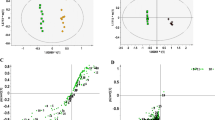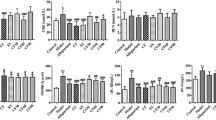Abstract
Objective
To ascertain the biomarkers capable to characterize the animal composite model of Chinese medicine (CM) Yinhuang (阴黄) syndrome induced by triplet factors of rhubarb, ethanol, and α-nephthylisothiolyanate (abbreviated as R, E, and A below) through metabolomic study and to evaluate the established model by means of studying the sources of markers based on the changes of metabolites produced from various combinations of the three modeling drugs.
Methods
Eighty Wistar rats allocated equally in eight groups (A–H) were treated with saline, R+E+A, R, E, A, R+E, R+A, and E+A, respectively. Rats’ 12 h urine in the 14 successive experimental days were collected separately using metabolic cages and analyzed by ultra peformance liquid chromatograph/time of flight mass spectrometer (UPLC/TOF-MS) to create the metabolic contour graph of urine in different groups for identifying the differences between them. The similarities and differences of metabolic network among various groups were represented from microcosmic viewpoint by pattern recognition method (principal component analysis).
Results
Controlled by group A, the landing points in principal component map of various groups were apparently assorted, especially obvious on the 14th day; 19 biomarkers, which capable to represent the genesis and development process of the Yinhuang syndrome in the triplet factors-induced rat model, were identified.
Conclusion
Metabolomic method is successfully used in evaluating the animal model of CM syndrome. Furthermore, according to the holistic view and substance changes in vivo, the influences of disease on organism were comprehensively analyzed, and the pathogenic mechanism of CM Yinhuang syndrome was explored at the level of metabolomics in vivo as well.
Similar content being viewed by others
References
Liu L, Sun H, Wang XJ, Wang P, Wu ZM, LU HT, et al. Hepatoprotection of YinChenHaoTang on acute rat liver injury induced by ethanol. World Sci Technol /Mod Tradit Chin Med Mater Med (Chin) 2007;9:35–40.
Stella C, Beckwith-Hall B, Cloarec O, Holmes E, Lindon JC, Powell J, et al. Susceptibility of human metabolic phenotypes to dietary modulation. J Proteome Res 2006;5:2780–2788.
Dumas ME, Barton RH, Toye A, Cloarec O, Blancher C, Rothwell A, et al. Metabolic profiling reveals a contribution of gut microbiota to fatty liver phenotype in insulin-resistant mice. Proc Natl Acad Sci USA 2006;103:12511–12516.
Zhang CZ, Zeng H, Cheng LB. Establish and significance of the Yin Jaundice paterner animal model. Chin J Basic Med Tradit Chin Med (Chin) 2000;6:43–44.
Lu JB, Zhang CZ, Yan XS. A study of apoptosis and gene regulation in peripheral blood lymphocytes of Yin Jaundice. Chin J Integr Tradit West Med Liver Dis (Chin) 2002;12:150–152.
Tian JZ, Wang YY, Shi J. Research thinking on syndrome model defined by traditional Chinese medicine. J Beijing Univers Tradit Chin Med (Chin) 2005;28:18–21.
Wan SH, Ding YQ, Pu XH, Guo L, Kang TG. Protective effect of Hydroxyan throquinones from Rheum Palmatum L on acute liver injure of rats induced by CCl4. Chin Pharmacol Bull (Chin) 2006;22:1405–1406.
Nicholson JK, Lindon JC, Holmes E. Metabonomics: understanding the metabolic responses of living systems to pathophysiological stimuli via multivariate statistical analysis of biological NMR spectroscopic data. Xeno Biotica 1999;29:1181–1189.
He J, Zhou HH. Metabonomics and its growing in sights into pharmacology. Chin Phamacol Bull (Chin) 2006;22S:1304–1309.
Wang XJ, Liu L, Sun H, Lu HT. Studieson themetabonomics of rat liver injury induced by ethanol and interfering efects of YinChenHaoTang. Chin Pharmacol Bull (Chin) 2008;24:452–457.
Nicholson JK, Connelly J, Lindon JC, Holmes E. Metabonomics: aplatform for studying drug toxicity and gene function. Nat RevDrug Discov 2002;1:153–161.
Author information
Authors and Affiliations
Corresponding author
Additional information
Supported by the Key Items of the National Program for Basic Sciences Research and Development (“973” Plan No. 2005CB523406)
Rights and permissions
About this article
Cite this article
Tong, X., Sun, H., Yan, Gl. et al. Evaluation study on urine metabolomics in Yinhuang (阴黄) rat model induced by triplet factors of rhubarb, ethanol, and α-nephthylisothiolyanate. Chin. J. Integr. Med. 17, 369–375 (2011). https://doi.org/10.1007/s11655-011-0728-9
Received:
Published:
Issue Date:
DOI: https://doi.org/10.1007/s11655-011-0728-9




